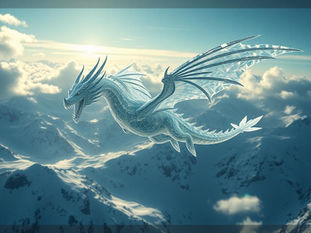
Improve Your AI Art: Simple Prompting Guide
Apr 29
5 min read
0
1
0

Have you ever tried creating an image with AI, but the results just aren't what you hoped for? It happens to everyone. Crafting the right words to tell the AI what you want is key. This guide shares simple but important tips for prompting AI image tools like Midjourney, Stable Diffusion, and Fooocus. We'll cover the basics, common mistakes, and how to get closer to your vision.
What is a Text Prompt?
Think of the text prompt as how you talk to the AI. You're telling it exactly what to draw. Imagine asking a friend to make a picture, but you have to write down every detail. The AI is a bit like a friend who understands main words but might miss the full meaning of sentences. This is why writing like you talk to a person often doesn't work well. The AI sees keywords and tries its best to put them together.
Keep Your Prompts Simple First
When starting a prompt, it's usually best to begin simple. Add more details as needed. Using very long, super descriptive prompts can confuse the AI. You see this often with new users who copy prompts and end up with pages of text. This often doesn't lead to good images.
The trick is finding a balance. Be clear enough so the AI knows what you want, but also leave some room for it to create. Start with the main ideas: your subject, a few key objects, and the general feeling you want. Get a basic image first. If something is wrong, like everything is too red, then add more specific words to fix it.
You can also use other AI like ChatGPT to help brainstorm short, concise prompts. Just be sure to tell it you need a simple version, not a long one.
Ingredients for a Good Prompt
Think of your prompt as a recipe. You need different elements to make a good image:
**Subject:** Who or what is the main focus? A person, animal, place, or object.
Adjectives: Words that describe the subject or the scene. How do things look?
Action/Activity: What is the subject doing? (e.g., running, sitting, flying).
Environment/Setting: Where is it happening? (e.g., forest, city street, inside a house).
Mood/Atmosphere: How should the image feel? (e.g., peaceful, dramatic, happy). Adding these keywords can change the whole look.
Medium/Style: Do you want it to look like a watercolor painting, a realistic photo, or maybe the style of a specific artist? Mention it.
Perspective/Composition: How is the "camera" viewing the scene? (e.g., close-up, wide shot, from above). This changes the layout of the image.
All these parts work together. If the words you try don't work, use a thesaurus to find similar words. The AI might understand a different term better.
Writing Your Prompt: Sentences or Keywords?
You can write prompts in full sentences. However, many people find better results using short phrases or just keywords, separated by commas. For example, "a cat walking down a hill surrounded by high grass" might give similar results to "cat, walking, hill, high grass." The best way to learn is to try both and see what works for you.
Starting simple and adding words lets you see exactly how each addition changes the image. This is easiest if you use the same starting point (seed) each time you add to the prompt.
For users of the TitanXT Midjourney Automation Suite ([LINK url="https://www.titanxt.io/midjourneyautomator"]), experimenting with different prompt structures is easy. The tool helps manage different versions and see how small changes impact your results.
Understanding Prompt Weight
Prompt weight helps you tell the AI which words or phrases are most important. Words at the start of a prompt naturally have more weight, especially in longer prompts. For shorter prompts, the order might not matter as much.
Another way to add weight is by using symbols or controls depending on your tool. Some tools use parentheses around words to make them more important. ([word]) gives it more weight, ((word)) even more. Other tools let you increase or decrease word weight using keyboard shortcuts (like Ctrl + up/down arrows in Fooocus). A weight of 1.0 is standard. Going slightly higher, like 1.1 to 1.5, works well. Much higher than 1.5 can lead to odd results. Adjusting weights is helpful when the AI isn't focusing enough on a certain detail.
You can use weights in negative prompts too. If you're trying hard to remove something, adding weight to that word in the negative prompt can sometimes help.
The Association Effect
This is a big one to be aware of. The AI has learned from huge amounts of data. When you use certain words, other things that are often linked to them might appear in your image, even if you didn't ask for them. For example, asking for a "nurse talking to a patient" might mostly give you images of female nurses, because "nurse" is often associated with women in the training data.
The same happens with things like celebrities or even physical traits. Ask for "Taylor Swift in a dress," and you might get images with styles and poses common for her. Ask for "a young female with blue eyes," and you might get certain hair colors or looks that are often shown with blue eyes in the data.
Be aware of these potential links when writing prompts. If you see unexpected things appear, think about the associations your words might have. Using a thesaurus to find different terms can help avoid this effect. Remember that different AI models might have different associations based on the data they were trained on.
A Common Prompting Mistake
A frequent error, especially for beginners, is putting things you *don't* want in the positive prompt. For example, if you want a car without tires, writing "an old car without tires" might actually make tires appear! The AI focuses on the word "tires" even with "without" there.
Things you want to avoid should usually go in the negative prompt section of your tool, if available. If you're having trouble with something unwanted showing up, move that word there. Or, try to rephrase your positive prompt in a way that describes what you *do* want, avoiding words linked to the unwanted elements.
Using a powerful tool like the Midjourney Automation Suite can help you test different prompt variations and see instantly how small changes, like moving a term to the negative prompt or rephrasing, impact your final image.
Try This Prompting Challenge
Here's a challenge based on a tricky example: Can you write a good prompt for a car sitting on blocks or a lift, with no tires on the vehicle? The goal is to get this result without using a negative prompt. It requires creative wording to guide the AI correctly! Feel free to try it out with your favorite AI tool and share your successful prompts.
Final Thoughts
Prompting AI is like learning a new language. Start simple, understand which words are key, and experiment with how different words affect your images. Pay attention to prompt weight and the association effect. By avoiding common mistakes and using the principles discussed, you can significantly improve the quality and control over your AI-generated art.
Have fun creating!






